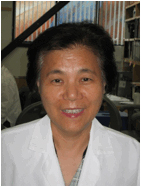Laboratory of Rare Lung Diseases
Meiqi Jiang, M.D., Ph.D.
 Senior Research Investigator
Senior Research Investigator
University of Pennsylvania Medical Center
Pulmonary, Allergy, & Critical Care Division
Translational Research Laboratories (TRL)
125 South 31st Street, TRL Suite 1200
Philadelphia, PA 19104-3413
(215) 746-2891
(215) 746-1224
mjiang@mail.med.upenn.edu
Education:
M.D., M.S., Peking University Medical School (Beijing Medical University), Beijing, China
PhD, University of Iowa, Iowa City, IA, USA
Residency:
Peking University Medical School, First Hospital, Beijing
Clinical Research Fellowship:
University of Iowa Medical School, Iowa City, IA
Postdoctoral Fellowship:
University of Pennsylvania, Philadelphia, PA
Dr. Jiang joined the Airway Biology Initiative (ABI) in 2003. Her basic science research has focused on electro-physiology study of airflow obstruction and airway remodeling as seen in murine models of asthma and ozone hyper-responsiveness. The goal of these studies has been to identify the mechanisms that regulate airway smooth muscle cell growth and to hopefully discover new and novel therapeutics for the treatments of asthma. In the clinical practice, she supervises the clinical trials specimen processing (bronchoalveolar lavage fluid, blood, sputum, urine) from the patients with either asthma or COPD.
Selected Publications
- Balenga NA, Jester W, Jiang M, Panettieri RA Jr, Druey KM. Loss of regulator of G protein signaling 5 promotes airway hyperresponsiveness in the absence of allergic inflammation. J Allergy Clin Immunol. 2014 Mar 22. [Epub ahead of print]
- Banerjee A, Trivedi CM, Damera G, Jiang M, Jester W, Hoshi T, Epstein JA, Panettieri RA Jr. Trichostatin A abrogates airway constriction, but not inflammation, in murine and human asthma models. Am J Respir Cell Mol Biol. 2012 Feb; 46(2):132-8.
- Damera G, Jester WF, Jiang M, Zhao H, Fogle HW, Mittelman M, Haczku A, Murphy E, Parikh I, Panettieri RA, Jr. Inhibition of myristoylated alanine-rich c kinase substrate (marcks) protein inhibits ozone-induced airway neutrophilia and inflammation. Exp. Lung Res., 36(2): 75-84, 2010 Mar. Erratum in: Exp Lung Res. 2010 Jun;36(5):321.
- Damera G, Jiang M, Zhao H, Fogle HW, Jester WF, Freire J, Panettieri RA Jr. Aclidinium bromide abrogates allergen-induced hyperresponsiveness and reduces eosinophilia in murine model of airway inflammation. Eur J Pharmacol., 649(1-3):349-53. 2010 Dec 15.
- Wang M, Cooper PR, Jiang M, Zhao H, Hui Y, Yao Y, Tate JC, Damera G, Lawson JA, Jester WF Jr, Haczku A, Panettieri RA Jr, FitzGerald GA. Deletion of microsomal prostaglandin E synthase-1 does not alter ozone-induced airway hyper-responsiveness. J Pharmacol Exp Ther., 334(1):63-8. 2010 Jul.
- Jiang MQ, Thompson HS, Lam BL. Kestenbaum's number as an indicator of pupillomotor input asymmetry.Am J Ophthalmol. 1989 May 15;107(5):528-30.
- Thompson HS, Jiang MQ. Intensity of the stimulus light influences the measurement of the relative afferent pupillary defect. Ophthalmology. 1987 Oct;94(10):1360-2.
- Jiang MQ, Thompson HS. Pupillary defects in retinitis pigmentosa. Am J Ophthalmol. 1985 May 15; 99(5): 607-8.
